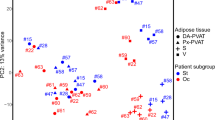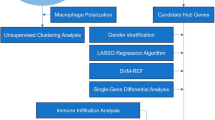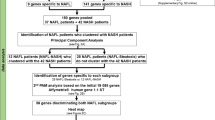Abstract
Background:
The metabolic syndrome describes the association between obesity and co-morbidities including insulin resistance, hypertension, dyslipidemia, and cardiovascular (CV) disease. Adipokines produced from omentum contribute to the risk of CV disease and increase the inflammatory state. This study examines the gene expression differences in the omental tissue of morbidly obese diabetic and non-diabetic patients.
Methods:
Twenty morbidly obese patients undergoing bariatric surgery were included. Ten patients were diabetic and 10 were non-diabetic. Omental samples were collected intraoperatively and snap frozen. Total RNA was extracted using the Trizol reagent and purified with the RNeasy kit (Qiagen). Microarray experiments were performed using the Affymetrix Gene 1.0 ST array and data was analyzed with the Partek 6.3 program using an unpaired t-test (P<0.05). The gene expression profiles of the diabetic group were compared with the non-diabetic group. Using the Ingenuity program, the gene list generated from the microarray analysis was evaluated and real-time quantitative PCR (qPCR) was used to validate the array data.
Results:
Compared with the non-diabetic group, the diabetic obese patients showed 79 upregulated genes and 4 downregulated genes with >1.4-fold difference in expression. Ingenuity analysis showed numerous dysregulated genes associated with CV disease including leptin, Von Willebrand factor, P-selectin, angiopoietin-1 (ANGPT1), phospholipase A2 (group VII), and periostin osteoblast specific factor. Microarray results for the earlier mentioned genes were confirmed with qPCR. The results were analyzed with respect to the presence or absence of hyperlipidemia, hypertension, and coronary artery disease. In patients with hyperlipidemia, ANGPT1 and P-selectin were upregulated 1.9- and 2.9-fold, respectively.
Conclusions:
This microarray analysis of omental tissue from morbidly obese diabetic patients documents a host of upregulated genes related to CV disease. This study provides further evidence that diabetic status predisposes obese patients to a higher risk of developing CV disease.
This is a preview of subscription content, access via your institution
Access options
Subscribe to this journal
Receive 12 print issues and online access
$259.00 per year
only $21.58 per issue
Buy this article
- Purchase on Springer Link
- Instant access to full article PDF
Prices may be subject to local taxes which are calculated during checkout



Similar content being viewed by others
References
Ogden CL, Carroll MD, Curtin LR, McDowell MA, Tabak CJ, Flegal KM . Prevalence of overweight and obesity in the United States, 1999-2004. JAMA 2006; 295: 1549–1555.
Ogden CL, Yanovski SZ, Carroll MD, Flegal KM . The epidemiology of obesity. Gastroenterology 2007; 132: 2087–2102.
Annual meeting of the North American Association for the Study of Obesity. October 29–November 2, 2000. Long Beach, California, USA. Abstracts. Obes Res 2000; 8 (Suppl 1): 1S–138S.
Mokdad AH, Ford ES, Bowman BA, Dietz WH, Vinicor F, Bales VS et al. Prevalence of obesity, diabetes, and obesity-related health risk factors, 2001. JAMA 2003; 289: 76–79.
Mokdad AH, Marks JS, Stroup DF, Gerberding JL . Correction: actual causes of death in the United States, 2000. JAMA 2005; 293: 293–294.
Batsis JA, Nieto-Martinez RE, Lopez-Jimenez F . Metabolic syndrome: from global epidemiology to individualized medicine. Clin Pharmacol Ther 2007; 82: 509–524.
Perugini RA, Quarfordt SH, Baker S, Czerniach DR, Litwin DE, Kelly JJ . Metabolic characterization of nondiabetic severely obese patients undergoing Roux-en-Y gastric bypass: preoperative classification predicts the effects of gastric bypass on insulin-glucose homeostasis. J Gastrointest Surg 2007; 11: 1083–1090.
McNeill AM, Rosamond WD, Girman CJ, Heiss G, Golden SH, Duncan BB et al. Prevalence of coronary heart disease and carotid arterial thickening in patients with the metabolic syndrome (The ARIC Study). Am J Cardiol 2004; 94: 1249–1254.
Mathier MA, Ramanathan RC . Impact of obesity and bariatric surgery on cardiovascular disease. Med Clin North Am 2007; 91: 415–431 x–xi.
Malik S, Wong ND, Franklin SS, Kamath TV, L’Italien GJ, Pio JR et al. Impact of the metabolic syndrome on mortality from coronary heart disease, cardiovascular disease, and all causes in United States adults. Circulation 2004; 110: 1245–1250.
Tchernof A . Visceral adipocytes and the metabolic syndrome. Nutr Rev 2007; 65: S24–S29.
Matsuzawa Y . The role of fat topology in the risk of disease. Int J Obes 2008; 32 (Suppl 7): S83–S92.
Despres JP, Despres J-P . Targeting abdominal obesity and the metabolic syndrome to manage cardiovascular disease risk. Heart 2009; 95: 1118–1124.
Peral B, Camafeita E, Fernandez-Real JM, Lopez JA, Peral B, Camafeita E et al. Tackling the human adipose tissue proteome to gain insight into obesity and related pathologies. Expert Rev Proteomics 2009; 6: 353–361.
Sharma AM, Sharma AM . The value of current interventions for obesity. Nat Clin Pract Cardiovasc Med 2008; 5 (Suppl 1): S3–S9.
Wajchenberg BL, Giannella-Neto D, da Silva ME, Santos RF . Depot-specific hormonal characteristics of subcutaneous and visceral adipose tissue and their relation to the metabolic syndrome. Horm Metab Res 2002; 34: 616–621.
Verna EC, Berk PD, Verna EC, Berk PD . Role of fatty acids in the pathogenesis of obesity and fatty liver: impact of bariatric surgery. Semin Liver Dis 2008; 28: 407–426.
Hartge MM, Unger T, Kintscher U . The endothelium and vascular inflammation in diabetes. Diab Vasc Dis Res 2007; 4: 84–88.
Nathan C . Epidemic inflammation: pondering obesity. Mol Med (Cambridge, Mass) 2008; 14: 485–492.
Spencer CG, Gurney D, Blann AD, Beevers DG, Lip GY . Von Willebrand factor, soluble P-selectin, and target organ damage in hypertension: a substudy of the Anglo-Scandinavian Cardiac Outcomes Trial (ASCOT). Hypertension 2002; 40: 61–66.
Conway DS, Pearce LA, Chin BS, Hart RG, Lip GY . Plasma von Willebrand factor and soluble p-selectin as indices of endothelial damage and platelet activation in 1321 patients with nonvalvular atrial fibrillation: relationship to stroke risk factors. Circulation 2002; 106: 1962–1967.
Schnabel R, Dupuis J, Larson MG, Lunetta KL, Robins SJ, Zhu Y et al. Clinical and genetic factors associated with lipoprotein-associated phospholipase A(2) in the Framingham Heart Study. Atherosclerosis 2008; 204: 601–617.
Brindle NP, Saharinen P, Alitalo K . Signaling and functions of angiopoietin-1 in vascular protection. Circ Res 2006; 98: 1014–1023.
Shimazaki M, Nakamura K, Kii I, Kashima T, Amizuka N, Li M et al. Periostin is essential for cardiac healing after acute myocardial infarction. J Exp Med 2008; 205: 295–303.
Costello CM, Howell K, Cahill E, McBryan J, Konigshoff M, Eickelberg O et al. Lung-selective gene responses to alveolar hypoxia: potential role for the bone morphogenetic antagonist gremlin in pulmonary hypertension. Am J Physiol Lung Cell Mol Physiol 2008; 295: L272–L284.
Ahima RS . Revisiting leptin's role in obesity and weight loss. J Clin Invest 2008; 118: 2380–2383.
Chen JX, Zeng H, Lawrence ML, Blackwell TS, Meyrick B . Angiopoietin-1-induced angiogenesis is modulated by endothelial NADPH oxidase. Am J Physiol Heart Circ Physiol 2006; 291: H1563–H1572.
MacLaren R, Cui W, Simard S, Cianflone K . Influence of obesity and insulin sensitivity on insulin signaling genes in human omental and subcutaneous adipose tissue. J Lipid Res 2008; 49: 308–323.
Dolinkova M, Dostalova I, Lacinova Z, Michalsky D, Haluzikova D, Mraz M et al. The endocrine profile of subcutaneous and visceral adipose tissue of obese patients. Mol Cell Endocrinol 2008; 291: 63–70.
Alberti L, Gilardini L, Zulian A, Micheletto G, Peri G, Doni A et al. Expression of long pentraxin PTX3 in human adipose tissue and its relation with cardiovascular risk factors. Atherosclerosis 2009; 202: 455–460.
O’Rourke RW, Metcalf MD, White AE, Madala A, Winters BR, Maizlin II et al. Depot-specific differences in inflammatory mediators and a role for NK cells and IFN-[gamma] in inflammation in human adipose tissue. Int J Obes 2009; 33: 978–990.
Fain JN, Sacks HS, Buehrer B, Bahouth SW, Garrett E, Wolf RY et al. Identification of omentin mRNA in human epicardial adipose tissue: comparison to omentin in subcutaneous, internal mammary artery periadventitial and visceral abdominal depots. Int J Obes 2008; 32: 810–815.
Acknowledgements
We thank The Richard B and Lynne V Cheney Cardiovascular Institute and the Catharine B and William McCormick Trust for financial support.
Author information
Authors and Affiliations
Corresponding author
Ethics declarations
Competing interests
The authors declare no conflict of interest.
Rights and permissions
About this article
Cite this article
Hindle, A., Edwards, C., McCaffrey, T. et al. Identification of cardiovascular genes in omentum from morbidly obese patients with type 2 diabetes. Int J Obes 34, 1020–1027 (2010). https://doi.org/10.1038/ijo.2010.23
Received:
Revised:
Accepted:
Published:
Issue Date:
DOI: https://doi.org/10.1038/ijo.2010.23



